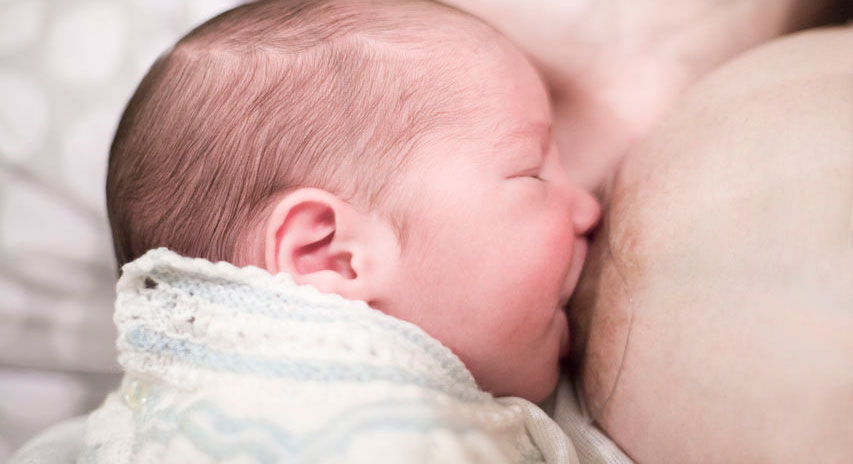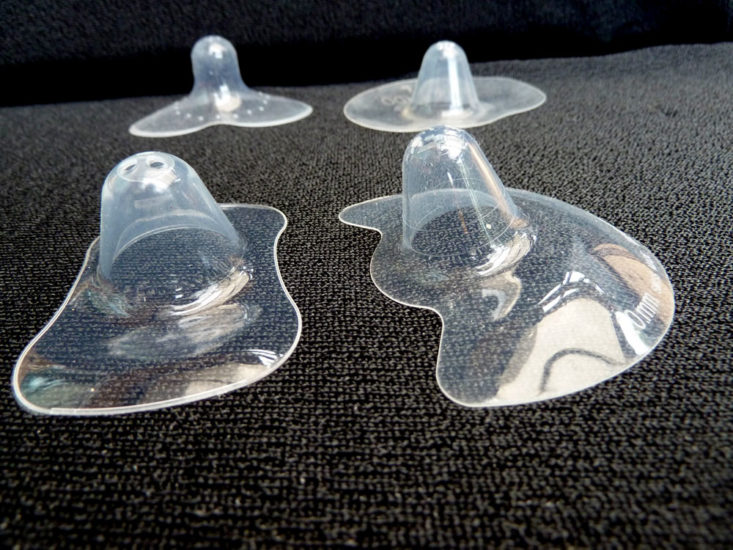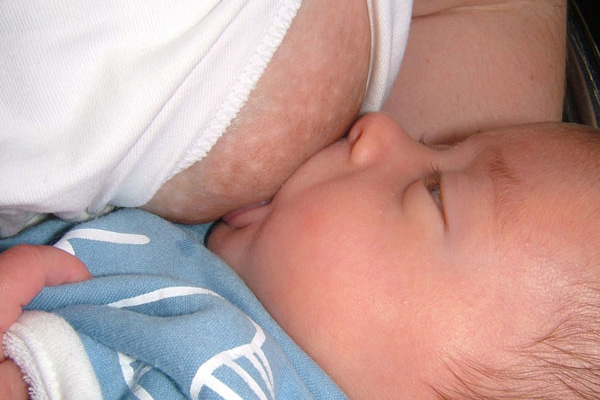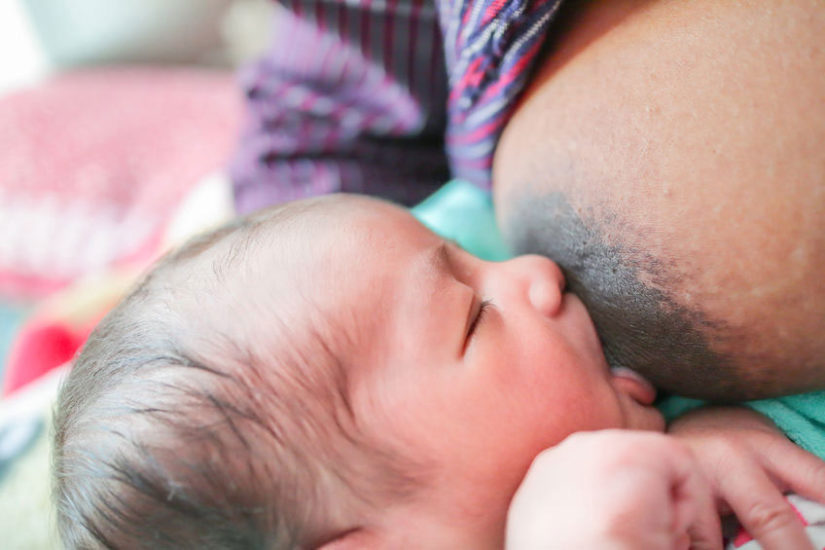A nipple shield is a soft protective cover that can be worn over the nipple and areola during breastfeeding. A nipple shield is shaped like a tiny Mexican hat with a high crown that covers the nipple and a wide brim that fits against the breast. Made of thin and flexible silicone, nipple shields have a number of holes in the tip through which a baby can receive breast milk. Some breastfeeding helpers think nipple shields can be useful sometimes and others strongly disapprove of them. Are nipple shields OK to use or not?! This article looks at the situations where nipple shields may be suggested to help keep breastfeeding going, and discusses their pros and cons.
When might a nipple shield be used?
#1 Flat nipples, short nipples or inverted nipples
When a baby feels a firm nipple against the roof of his mouth it will usually trigger even a sleepy baby’s sucking reflex and help them grasp and attach to the breast (latch). It follows that if a mother has quite flat or inverted nipples, her baby may find it more difficult to grasp and suckle the breast if he does not feel this trigger. Locating a flatter nipple may be even more difficult for a baby who is very sleepy after a stressful or medicated birth. In this situation, a well fitted nipple shield can provide that firm touch or trigger to the baby’s palate to get breastfeeding going.
Seek specialist help
Given a little time, plenty of skin-to-skin, and some skilled help with latching and positioning, many babies can breastfeed with flat or even inverted nipples without a shield. Try contacting a breastfeeding specialist for help and support before reaching for nipple shields and see Breastfeeding With Inverted Nipples and Flat Nipples.
Avoid shields in the first few days
Jack Newman—a Canadian paediatrician and breastfeeding specialist—cautions against the practice of using nipple shields for a baby who won’t latch in the first few days before a mother’s milk has come in:
Using a nipple shield before the mother’s milk comes in should absolutely not be done. Once the milk comes in, the baby often latches on. If the baby is on a nipple shield, the mother may delay getting help when the milk comes in because she thinks the problem is solved. It’s not, and in many cases, the milk supply decreases with time.
#2 Premature babies
Arriving in the world early can present feeding challenges for premature babies, some of whom may find it difficult to latch at first. Skin-to-skin or kangaroo care can be particularly helpful for these little babies to help stabilise their body systems and prime their instinctive feeding behaviour so they can concentrate on learning to suckle. A well fitted nipple shield is a possible tool to provide a firm sucking trigger to help a premie to maintain their latch and suck.1 However not all premature babies will need one, seeking good skilled help may be all that you need to get breastfeeding off to a good start.
#3 Sore nipples
If breastfeeding is very painful or a mother’s nipples are sore or cracked, a well fitted nipple shield can act like a glove protecting the nipples and allowing mum some pain relief until she can get some help with the latch or while her nipples heal. Used this way, shields can help to keep breastfeeding going for mother and baby. However it’s important to solve the cause of the original nipple damage and not just use the shield as a quick fix. See Why Does Breastfeeding Hurt? for ideas to solve painful feeding or find a good breastfeeding helper. If your baby continues to latch on the nipple (or tip of the shield) rather than the breast, your baby may not be able to get enough milk and breastfeeding will likely still be painful. With good positioning and a corrected deep latch, breastfeeding will be more comfortable, even with a sore or damaged nipple.
#4 Nipple confusion
If your baby has got used to bottle teats and become confused about latching to a breast, or is refusing to latch at all (sometimes called a nursing strike), a nipple shield can help to transition your baby back to the breast because the shield feels, smells and tastes more like a bottle teat. How to Get Baby Back to the Breast and When Baby Won’t Breastfeed have more ideas to help you in this situation.
#5 Individual anatomy
Sometimes a nipple shield can be useful as a latching aid or type of training exercise for a baby who is struggling to breastfeed due to their individual anatomy. For example if a baby is not extending his tongue to wrap around the breast due to a tongue-tie or high muscle tone or if they have a small or receding jaw or unusually shaped palate, a nipple shield may be useful temporarily or even longer-term. An IBCLC lactation consultant can help to assess how your baby is breastfeeding and what positions or suggestions may help them. Babies with high palates or a tongue-tie can have a sensitive gag reflex which may be stimulated by a nipple shield and they may need different exercises or treatment.2
What are the disadvantages of nipple shields?
Nipple shields may reduce the milk available to your baby
Some nipple shields (especially the earlier thicker versions) can make it much harder for your baby to get enough milk and can reduce your milk supply. After all the silicone shield is an extra layer or barrier between you and your baby. Despite this potential problem, one recent study in 2021 found that milk transfer wasn’t reduced where nipple shields were used regularly to prevent nipple pain.3 To avoid any problems;
- Check that your baby is latching deeply on the shield with a wide open mouth and isn’t just on the tip of the shield
- Make sure the shield is big enough, if it is too small it can restrict the milk available to your baby
- Try gentle breast compressions during a feed to help your baby get more milk
- Keep a count of your baby’s dirty nappies and check their weight gain regularly to make sure they are getting enough milk
- If there is a concern about low milk, try hand expressing or pumping after a feed and topping your baby up with the expressed milk. This will protect your milk supply and help to keep your baby well fed. There are more ideas for making more milk in How to Make More Breast Milk.
Increased risk of blocked ducts or mastitis
If a baby is not able to drain the breasts of milk very well due to the nipple shield, there could be an increased risk of a mother getting engorged breasts (breasts uncomfortably swollen with excess milk) which could lead to a blocked duct or breast inflammation (mastitis). Frequent feeds, breast movement, and pumping or hand expressing after feeds if needed can all help with thorough breast drainage if this should be a problem—see Engorged Breasts for more ideas.
A difficult habit to break
Once a baby has got used to using a shield it can sometimes be difficult to stop using them. To avoid the extra complications that nipple shields bring it’s worth trying to get problems sorted out early by getting expert help from an experienced IBCLC lactation consultant.
Where can I get nipple shields?
Most baby stores will sell nipple shields or you can also find them online. Different brands have slightly different shapes and usually come in several sizes. For example:
- Mamivac have conical shaped small (18mm), medium (20mm) and large (28mm) or cherry shaped small (18mm) or medium (22mm)
- Ardo’s Tulip shields are available as small (16mm), medium (20mm) and large (24mm)
- Medela sell shields that are small (16mm), medium (20mm) or large (24mm)
Check reviews on nipple shield brands carefully before buying and avoid any with consistently bad reviews. Some nipple shields are poorly designed and can rub a mother’s nipple, for example some even have raised ridges on the inside of the shield.
Which size or shape do I need?
It can be trial and error to find the right shape and size that works for you and your baby. A baby’s individual mouth size and mother’s nipple and breast size will need to be taken into account. To accommodate nipple variations, a mother may need different sizes for each breast.
- Choose the largest size that works well for you and your baby
- Avoid a shield that is too small which can rub your nipple and restrict milk flow, there needs to be enough room for your nipple to stretch during feeding.
- Find a comfortable shape. Some nipple shields have more of a rounded nipple tip than popular brands Medela, Mamivac or Ardo which have a dome shape. As with size, choose a style that allows enough room for your nipple to stretch during the feed, otherwise it may be uncomfortable and slow milk flow.
Larger nipples
The largest shield that I am aware of is the 28mm Mamivac shield.
Cut away shields
While some shields make a full circle shape around the nipple, others are more of a half-circle shape so that an area of silicone is cut away. Most manufacturer’s recommend that this cut away area be lined up with baby’s nose so they are able to smell the breast—helping their feeding instincts. However, some lactation consultants prefer to turn the shield around so that the cut away area is alongside baby’s chin/lower jaw allowing some skin-to-skin contact between the tongue and breast. There is no right or wrong way if one works better than another. Some cut away styles may be harder to keep in place on the breast, it is worth trying different brands.
Shields with a flow loop. A new gimmick in 2025 is a nipple shield which has an additional silicone tube or “flow loop” through which breast milk can flow. The idea is that during a breastfeed any breast milk circulating in this clear tube will be visible and will reassure parents that their baby is getting plenty of milk. However the presence of milk in the loop won’t show how much milk a baby is actually swallowing and many lactation consultants are very concerned about mothers using this shield as a way to gauge their milk supply. For well established, traditional ways to check on how much milk your baby is getting see Is My Baby Getting Enough Milk?
Latching with a nipple shield
A baby is latched well to the breast when they have a big mouthful of breast tissue as well as the nipple in what is often called a deep latch. The same deep latch is desirable with a nipple shield. A baby can still have a wide open mouth with plenty of breast tissue as well as the nipple inside their mouth with a nipple shield in place. See Latching Tips for general latching help.
Applying a shield
Tips for using a nipple shield include:
- Warm the shield first in hot water to make it more flexible (optional)
- A little breast milk, water or lanolin under the flat part or brim of the shield can help the shield stay in place on the breast and prevent chaffing
- Expressing a little milk into the tip of the shield and initiating the let down before latching can encourage your baby with an instant reward of milk
- Turn the shield partly inside out before placing centrally over the nipple and then smooth down the edges so that the nipple is drawn into the shield
- Manufacturers recommend the cut away part of the shield should line up with baby’s nose once they are latched, but some mothers find having the cut away area against the baby’s chin works well
- Ensure baby takes the shield deeply into their mouth so they are not just latched onto the crown (tip) of the shield
- Your nipple should not be rubbed or feel sore during the feed and after feeding your nipple should not look flattened or distorted.
Video
A six minute video showing the steps for applying a shield can be found in Nipple Shields, by the Australian Breastfeeding Association, 2022.

Cleaning the nipple shield
Medela recommend shields be rinsed in cool water to remove breast milk, then washed with warm soapy water and rinsed well with cold water after each use. Shields can be sterilised once a day if required e.g. by boiling in water for ten minutes 4 or follow other manufacturers’ individual recommendations.
Not all bad
In a Breastfeeding Today article, lactation consultant and author Nancy Mohrbacher explained that modern shields are much thinner and less detrimental to breastfeeding than previous shields and when used correctly may preserve the breastfeeding relationship for short or even longer term use.
A mother can feel at ease about using the shield as long as it helps the baby breastfeed more effectively. In general, as the baby matures, his coordination increases, and as he develops more practice and positive associations at the breast, the easier it will be to wean him from the shield. A baby may need the shield for one feeding, a few feedings, a few days, a few weeks, or very rarely, a few months. If the baby is unable or unwilling to breastfeed without the shield, chances are the problem that caused the baby to need the nipple shield in the first place is not yet completely resolved. A mother who wants to wean from the shield should take her cues from her baby but keep trying to offer the breast without the shield every few days.
Weaning from a nipple shield
Some babies switch happily between breast and bottle and some will switch easily from a nipple shield back to a breast. However some babies develop a preference for the familiar feel of the nipple shield. If your baby refuses to latch without the nipple shield after a period of using one, see our article Weaning From A Nipple Shield.
Summary
Nipple shields can be helpful to keep breastfeeding going sometimes. It’s not the end of the world if you have to use one but it might be an early end to your milk supply if they are not used correctly. If you are wondering whether to use them, or whether your problems could be solved another way, seek out an experienced breastfeeding helper such as an IBCLC lactation consultant for help and support.



